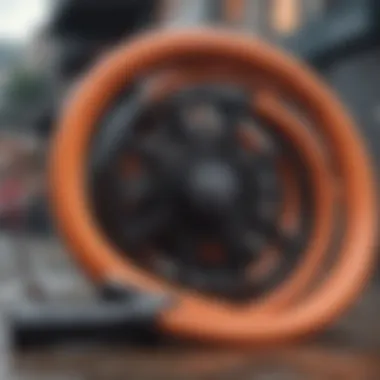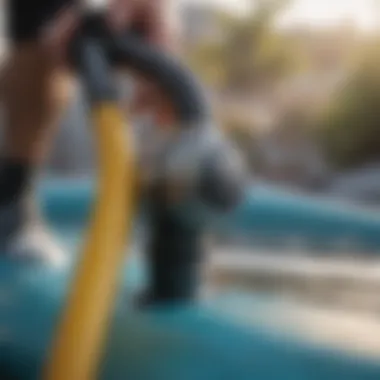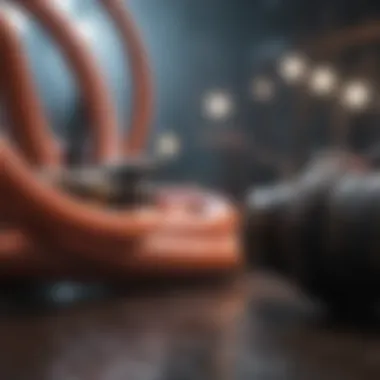Essential Guide to SUP Electric Pump Hose Replacement


Intro
Replacing the hose of your SUP electric pump is an essential maintenance task that can greatly enhance the performance and longevity of your equipment. As paddleboard enthusiasts, understanding the intricacies of this replacement process not only helps in ensuring optimal functionality but also fosters a deeper connection with the gear you use.
In this article, we will delve into the various types of hoses available, the signs that indicate a need for replacement, the step-by-step process to carry out the replacement, and lastly, maintenance tips to maximize the life of your electric pump system. Each section aims to provide valuable insights for both newcomers and seasoned paddleboarders engaged in this thrilling sport.
The History of the Sport
Origin and Evolution
Stand-Up Paddleboarding (SUP) traces its roots to ancient Polynesian cultures, where individuals rode large boards and used outrigger canoes to navigate waters. The practice became more mainstream in the late 20th century, evolving with the introduction of modern materials and designs. This evolution led to the creation of various paddle boards and electric pumps, which transformed the experience in ways previously unimaginable.
Milestones and Influences
A critical milestone occurred in 2005 when companies began developing specific boards designed solely for stand-up paddling. The accessibility of inflatable paddle boards opened the sport to a broader audience, driving up interest and participation worldwide. Innovations in electric pump technology have played a vital role in simplifying the setup process, allowing paddleboarders to spend more time on the water.
Key Athletes and Pioneers
Prominent figures like Laird Hamilton and Dave Kalama have been influential in popularizing SUP. Their contributions helped in advancing techniques and promoting paddleboarding as a legitimate extreme sport. This influence extended beyond just athletes; manufacturers began creating better gear, including electric pumps, as the demand for convenience soared.
Understanding Hose Types
Knowing the types of hoses available for your SUP electric pump can make a significant difference in your experience. Hoses typically vary in material and durability, affecting their performance.
- PVC Hoses: Commonly used, these hoses are lightweight and offer decent flexibility but may not be the most durable choice.
- Rubber Hoses: These hoses are more resilient, providing better performance under pressure but can be heavier.
- Reinforced Hoses: Made with additional materials that help withstand wear, ideal for heavy use.
Choosing the right hose is crucial, especially if you frequently use your paddleboard in varied conditions.
Signs Your Hose Needs Replacement
Recognizing the right time to change your hose extends the life of your pump and enhances performance reliability. Here are common signs:
- Cracks and Leaks: Visible damage or any sign of air loss while inflating is a clear indicator.
- Discoloration: A faded or brittle appearance can suggest deterioration of the material.
- Loss of Pressure: Difficulty maintaining pressure typically indicates that air is escaping from the hose.
Being observant about these warning signs can save you from unexpected inconveniences on your outings.
Process of Replacement
Changing the hose in your SUP electric pump is a straightforward task. Follow these steps for a seamless replacement:
- Gather Tools: You’ll need a wrench, new hose, and possibly some duct tape.
- Disconnect the Existing Hose: Use the wrench to detach the old hose from the pump carefully.
- Attach New Hose: Connect the new hose securely to the pump, ensuring there are no gaps.
- Test for Leaks: Once attached, run a test inflation to check for any air leaks. If all is well, you are good to go!
Maintenance Tips
To ensure the longevity of your SUP electric pump hose, consider these maintenance practices:
- Regular Inspections: Check for signs of wear after each use.
- Proper Storage: Avoid leaving the hose exposed to extreme temperatures.
- Clean After Use: Rinse off any saltwater or debris to prevent buildup.
By implementing these practices, you can enjoy longer, uninterrupted adventures on the water, fully equipped and prepared.
Regular maintenance of equipment facilitates seamless adventures and enhances the overall paddleboarding experience.
Preface to SUP Electric Pumps
Stand Up Paddle (SUP) electric pumps have transformed the way enthusiasts prepare for water adventures. The convenience these pumps offer is one of the most significant benefits. Unlike manual pumps, electric pumps save time and energy, allowing users to focus more on their paddleboarding experiences.
Electric pumps function as a reliable and efficient means of inflating paddleboards to the optimal pressure for performance. As technology has improved, the designs have become more compact and user-friendly, catering to both novice and seasoned paddlers.


Understanding SUP Technology
SUP technology encompasses a range of aspects that contribute to the overall paddleboarding experience. The core of this technology relates to the materials and design of the boards themselves, which have evolved dramatically over the years. Paddleboards are now made from advanced materials that offer durability, stability, and performance.
Electric pumps utilize technology that ensures consistency in the inflation process. They often feature built-in pressure gauges, allowing users to monitor the pressure levels effectively as the board inflates. Understanding these technological advancements is crucial as it reinforces the importance of proper equipment for safety and enjoyment while paddling.
Importance of Electric Pumps
Electric pumps are indispensable tools for paddleboarders. The primary function is, of course, to inflate the boards efficiently. However, the benefits extend beyond mere inflation. When you use an electric pump, you can achieve a consistent pressure across the entire board, which is vital for optimizing performance on water.
Moreover, electric pumps minimize the physical strain associated with manual pumping. This saves time and helps every paddler conserve their energy, improving their overall experience on the water. It is also worth mentioning that the ability to quickly deflate and pack the board enhances convenience. This is particularly relevant when you are at busy locations where time is of the essence.
In summary, understanding the mechanics and advantages of SUP electric pumps lays the foundation for better gear management. As evident, electric pumps are not just an accessory; they are essential for a seamless paddleboarding experience.
Hose Components in Electric Pumps
When discussing SUP electric pumps, it's essential to focus on hose components. The hose serves as a crucial link between the pump and the paddleboard. A well-functioning hose ensures optimal air flow, enhances performance, and increases the efficiency of the pumping process. Understanding the elements that make up the hose and their respective benefits can greatly affect the overall experience.
Material Types
The material of the hose directly impacts its durability and performance. Common types of materials used in electric pump hoses include latex, PVC, and reinforced rubber. Each material offers distinct advantages:
- Latex: Known for its flexibility and light weight, latex hoses can easily conform to tight spaces. However, they may not be as durable as other materials and are often prone to wear over time.
- PVC (Polyvinyl Chloride): This material is favored for its resistance to wear, water, and many chemicals. PVC hoses are typically more rigid than latex, which can affect their adaptability in certain situations.
- Reinforced Rubber: Often seen as the optimal choice for heavy-duty usage, reinforced rubber hoses provide a balance between flexibility and strength. They are thick and can withstand higher pressures, making them ideal for frequent use in extreme sports.
Choosing the appropriate material depends on how often and in what conditions the pump will be utilized. Understanding these properties helps in avoiding issues later.
Hose Specifications
Specifications of the hose play a pivotal role in the performance of an electric pump. This includes parameters such as diameter, length, and pressure handling capacity.
- Diameter: The internal diameter of the hose must match the pump's outlet. A mismatch can lead to inefficiencies, like reduced air flow or increased strain on the pump.
- Length: The overall length impacts the ease of use. While longer hoses may provide more reach, they can also introduce resistance, causing the pump to work harder.
- Pressure Rating: The hose needs to be rated for the pressure generated by the electric pump. Using a hose that cannot handle the required pressure may result in leaks or even hose failure.
In summary, hose components must be considered with a focus on materials and specifications. Choosing wisely can lead to an efficient pumping experience, allowing adventure seekers to enjoy their paddleboarding activities without hinderance.
Identifying Hose Issues
Identifying hose issues is crucial in maintaining the reliability and efficiency of your SUP electric pump. Ignoring this aspect can lead to performance declines and potential failures while out on the water. Whether you are a novice or an experienced paddleboarder, understanding the conditions that affect your hose can contribute to prolonged equipment life and enhance your overall experience. This section will outline common signs of wear and performance indicators that suggest a hose replacement is necessary.
Common Signs of Wear
Hoses are essential components of an electric pump. Over time, they can degrade due to various factors. Here are some common signs that should alert you to potential issues:
- Cracks or cuts: Visibly inspect the hose for any cracks or cuts. These can compromise the integrity of the hose and affect pumping efficiency.
- Discoloration: A change in color of the hose material, particularly to a faded or cracked appearance, might indicate aging and material degradation.
- Leaking: Noticeable leaks, either during operation or when pressurizing the hose, are critical indicators that the hose needs replacing.
- Kinks or bends: Persistent kinks in the hose can create weak spots that may eventually lead to bursts.
Performance Indicators
Focusing on performance indicators can also help in identifying potential hose issues. These are not always visually apparent, thus requiring more attention to how the pump operates:
- Decreased air pressure: If you observe that the pump is taking longer to inflate your board or is not reaching the desired pressure, it may be a sign of a damaged hose. This can lead to inefficient performance during your paddling adventures.
- Inconsistent airflow: Any interruption in airflow while pumping can indicate that the hose is blocked or compromised, potentially due to internal wear.
- Increased operating noise: An unusually loud operational noise while the pump is running could suggest issues with the hose or other internal components.
- Power consumption: A sudden change in the power draw of your pump can indicate resistance due to hose damage or blockage.
Regular attention to these signs can significantly impact the longevity of your pump and ensure that your paddleboarding experiences remain enjoyable and hassle-free.
By maintaining a vigilant eye on these factors, you can address hose issues before they escalate into more significant problems. Taking the time to inspect and recognize wear will lead to better performance and reliability during your outdoor activities.
Steps for Hose Replacement
Replacing the hose on an SUP electric pump is a task that can often seem daunting. However, it is a critical operation that ensures the proper functionality of your equipment. Neglecting this task can result in performance issues during paddleboarding adventures. This section emphasizes the significance of hose replacement, focusing on safety, efficiency, and the overall lifetime of your electric pump.
Gathering Required Tools


Before diving into the replacement process, it is essential to gather all the necessary tools. Having everything on hand makes the process smoother and reduces frustrations. Here are the primary tools you will need:
- Screwdriver (Phillips or flathead, depending on your pump’s design)
- Pliers
- Replacement hose (ensure it is compatible with your model)
- Measuring tape (to check hose length)
- Sealant tape (optional for better fitting)
Each tool plays a unique role in the replacement. The screwdriver assists in loosening screws, while pliers can help grip the hose more securely, if needed. Always verify that you have the right type of tools before you start. Missing something can lead to delays.
Removing the Old Hose
The removal process is crucial for a successful replacement. Begin by ensuring the pump is turned off and unplugged. If the pump has a power indicator light, check that it is off. Then, follow these steps:
- Locate the connection points of the hose. They are typically at the pump nozzle and the inlet port.
- Use the screwdriver to loosen the clamps holding the hose in place.
- Gently pull off the old hose. If it is stuck due to wear and tear, use pliers carefully. Avoid using excessive force to prevent damage to the connections.
- Inspect the area where the old hose was attached. Look for any debris or damage that may affect installation, and clean if necessary.
This step is straightforward but vital. A careful approach ensures you do not damage other components of the pump.
Installing the New Hose
With the old hose removed, you can proceed to the installation of the new hose. This step requires attention to detail to ensure a secure fit. Here's how to do it:
- Measure the new hose against the old one to verify compatibility. Ensure it fits well without any excess length.
- Place one end of the new hose onto the inlet port.
- Tighten the clamp around the new hose using the screwdriver. Ensure it is snug but not overly tight, as that can lead to damage.
- Repeat the same process at the nozzle end.
- If using sealant tape, wrap it around the connection prior to attaching the hose for additional sealing and security.
Confirm that the new hose is fitted correctly and securely, as this affects the performance of your SUP electric pump directly. A proper installation can dramatically reduce risks of leaks and enhance overall functionality.
Remember: Regular maintenance of your hoses can prevent unexpected failures, ensuring a smoother experience on the water.
Following these steps not only contributes to the longevity of your equipment but also to better paddleboarding experiences. Proper tools and techniques are essential for an effective hose replacement process.
Selecting the Right Replacement Hose
Choosing the right replacement hose for your SUP electric pump is crucial for ensuring optimal performance and longevity of your gear. A well-fitting and compatible hose will not only improve the efficiency of air compression but also affect the overall safety of your paddleboarding experience. The right hose contributes significantly to maintaining the pumping system's integrity and effectiveness.
There are several factors to keep in mind when selecting a replacement hose. You must consider brand compatibility, hose length, and pressure ratings, as these factors impact the functionality and reliability of the pump. By being thorough in your selection process, you can avert future complications that stem from poor-fitting or incompatible components.
Brand Compatibility
Brand compatibility is perhaps the most fundamental consideration when selecting a replacement hose. Different electric pump manufacturers often use unique designs and specifications for their hoses. Therefore, it is essential to choose a hose that is specifically designed to fit your pump's brand.
Using a hose not compatible with your pump can lead to various issues. You may experience air leaks, reduced performance, or even damage to your pump. Always check the manufacturer's recommendations or user manuals, as these often provide valuable guidance on compatible parts.
Hose Length Considerations
The length of the hose is another critical element in ensuring effective operation. A hose that is too short may restrict movement and flexibility, causing strain on the connection points. Conversely, a hose that is excessively long can lead to a decrease in air pressure due to extended air travel distance, impacting the pump's efficiency.
When determining the appropriate hose length, measure the distance from the pump to the paddleboard. It's often advisable to choose a length that allows some slack while not being too loose. Additionally, consider your paddling style and frequency of use; specific conditions may require different lengths.
Pressure Rating
The pressure rating of a hose is essential for performance and safety. Every electric pump has a maximum pressure it can safely handle. Selecting a hose with an insufficient pressure rating can lead to failures, leaks, or even dangerous malfunctions.
When purchasing a replacement hose, check the specifications for both the hose and your pump. Ensure that the hose can sustain pressures equal to or higher than the pump's maximum output. This precaution is paramount for reliable and safe operation of your equipment.
Always prioritize compatibility, appropriate length, and adequate pressure rating to ensure optimal performance from your SUP electric pump.
By focusing on these elements while selecting a replacement hose, you not only take responsible steps to safeguard your equipment, but also enhance your overall paddleboarding experience. Proper selection is foundational to the effective maintenance of your electric pump and hose, ensuring smooth adventures on the water.
Maintaining Your Electric Pump and Hose
Maintaining your electric pump and hose is essential for ensuring optimal performance and extending the life of your equipment. Like any mechanical system, a paddleboard pump requires regular care to function correctly. Here are some critical elements to consider:
- Durability: Regular maintenance prevents wear and tear, helping to avoid costly replacements.
- Performance: Keeping the pump and hose in good condition ensures efficient operation, allowing you to achieve the desired air pressure.
- Safety: Inspecting for any damage minimizes the risk of accidents during use.


By investing time in proper maintenance practices, you also enhance your overall paddleboarding experience. Understanding how to properly care for your equipment can make a significant difference in its operation.
Regular Inspection Practices
Regular inspections are a cornerstone of effective maintenance for your electric pump and hose. This ensures that any potential issues are identified early, thus avoiding unexpected failures. Make it a habit to check the following:
- Hose Integrity: Look for cracks, bulges, or leaks. These signs indicate the need for immediate replacement.
- Connector Condition: Ensure that the connectors are secure and do not show wear.
- Pump Functionality: Test the pump for strange noises or decreased performance. These could signal internal issues that requires attention.
Inspections should ideally be done before each use and after long periods of storage. This proactive approach can save both time and money in the long run.
Cleaning Guidelines
Maintaining cleanliness is vital to the longevity of your electric pump and hose. Here are some recommended cleaning practices:
- Rinse after Use: Always rinse your hose and pump with fresh water after use. This helps remove salt, dirt, and other debris that can cause damage over time.
- Dry Thoroughly: Ensure that the equipment is dried completely before storing it away. Moisture can lead to mold or mildew, which can deteriorate materials.
- Use Mild Cleaners: When necessary, use a non-abrasive cleaner to eliminate stubborn stains or buildup. Avoid harsh chemicals as they can degrade the materials.
By adhering to these cleaning guidelines, you not only preserve the functionality of your equipment but also enhance its aesthetic appearance. Keeping your electric pump and hose in tip-top shape is an essential part of getting the most out of your paddleboard activities.
Troubleshooting Common Issues
Troubleshooting common issues is an essential part of maintaining your SUP electric pump. Not only does it help to ensure the optimal performance of your pump, but it also enhances the longevity of the equipment. Recognizing when something is not quite right can save you time and money in the long run. In this section, we focus on two primary issues that paddleboard enthusiasts face: decreasing air pressure and electrical failures.
Decreasing Air Pressure
Decreasing air pressure can significantly impact the functionality of your electric pump. The first step in addressing this is recognizing the signs. If your pump takes longer than usual to inflate or you feel resistance during inflation, these may be indicators that air pressure is dropping.
Several factors could contribute to this issue:
- Worn Hose: A damaged or cracked hose may not maintain adequate air pressure.
- Loose Fittings: Ensure all connections are tight. Loose fittings can lead to air leaks, resulting in lower pressure.
- Environmental Conditions: Extreme temperatures can affect performance. Cold weather can cause the air to condense, thus lowering pressure.
To troubleshoot this issue, first inspect the hose for any visible damage or wear. If you find leaks, consider replacing the hose. It is also worth checking all connections to ensure they are secure. If the problem persists after these steps, further inspection of the pump itself is warranted.
Electrical Failures
Electrical failures can be quite frustrating, as they may prevent the pump from operating altogether. Understanding the underlying issues can help you address and resolve these problems efficiently.
The primary symptoms of electrical failure are:
- Pump Does Not Turn On: This may indicate a dead battery, faulty wiring, or a blown fuse.
- Unusual Noises: If the pump is producing noises that are not typical during operation, it may point to electrical malfunction.
- Intermittent Operation: If the pump turns off unexpectedly or struggles to maintain functionality, it may be an electrical concern.
Here are some common causes of electrical failures:
- Battery Issues: Ensure that the battery is charged and functioning properly. Batteries can suffer from wear and may need replacement.
- Wiring Connections: Inspect the wiring for any signs of damage or wear. Loose connections can lead to failures.
- Pump Overheating: If the pump gets too hot during operation, this can cause it to shut down as a safety measure.
To troubleshoot electrical failures, start by checking the battery status. Test the pump's wiring and connections to detect any loose or damaged components. If necessary, consult the manufacturer’s guide for specific troubleshooting steps or seek professional assistance.
Maintaining your pump and addressing these common issues can greatly enhance your paddleboarding experience.
Epilogue
Understanding the significance of hose maintenance in SUP electric pumps is crucial for any paddler. A well-functioning hose contributes directly to the efficiency and reliability of the whole system. When the hose is in good condition, it ensures that air is delivered optimally, allowing for faster and easier inflations. This function not only enhances performance but also adds to the overall experience of paddleboarding.
Regularly inspecting and replacing hoses when needed minimizes the risk of sudden pump failures, especially during critical moments on the water. Neglecting hose care can lead to leaks or pressure drops, which would hinder the pump's operation and potentially ruin a day of paddleboarding.
Furthermore, understanding the specifics of hose types, pressure ratings, and compatibility with electric pumps empowers users to make informed decisions. By being proactive about hose maintenance, paddlers can prolong the life of their equipment, achieve better performance, and maximize enjoyment on the water.
"A small investment in maintenance can prevent larger issues down the line."
The consequences of overlooking this aspect can be detrimental, leading to potential equipment damage or unsafe conditions. Ultimately, effective hose maintenance is not just about keeping gear in working order; it also enriches the adventure of water sports.
Final Thoughts on Hose Maintenance
- Check for signs of wear regularly: Small cracks or material breakdown can lead to larger issues.
- Choose quality replacement hoses: Matching the specifications of your pump is essential for optimal performance.
- Have a cleaning routine: Keeping the hose clean prevents dirt and debris accumulation, which can affect airflow.
Ultimately, a little attention to your pump's hose will yield substantial benefits, ensuring safe and enjoyable paddleboarding experiences.







